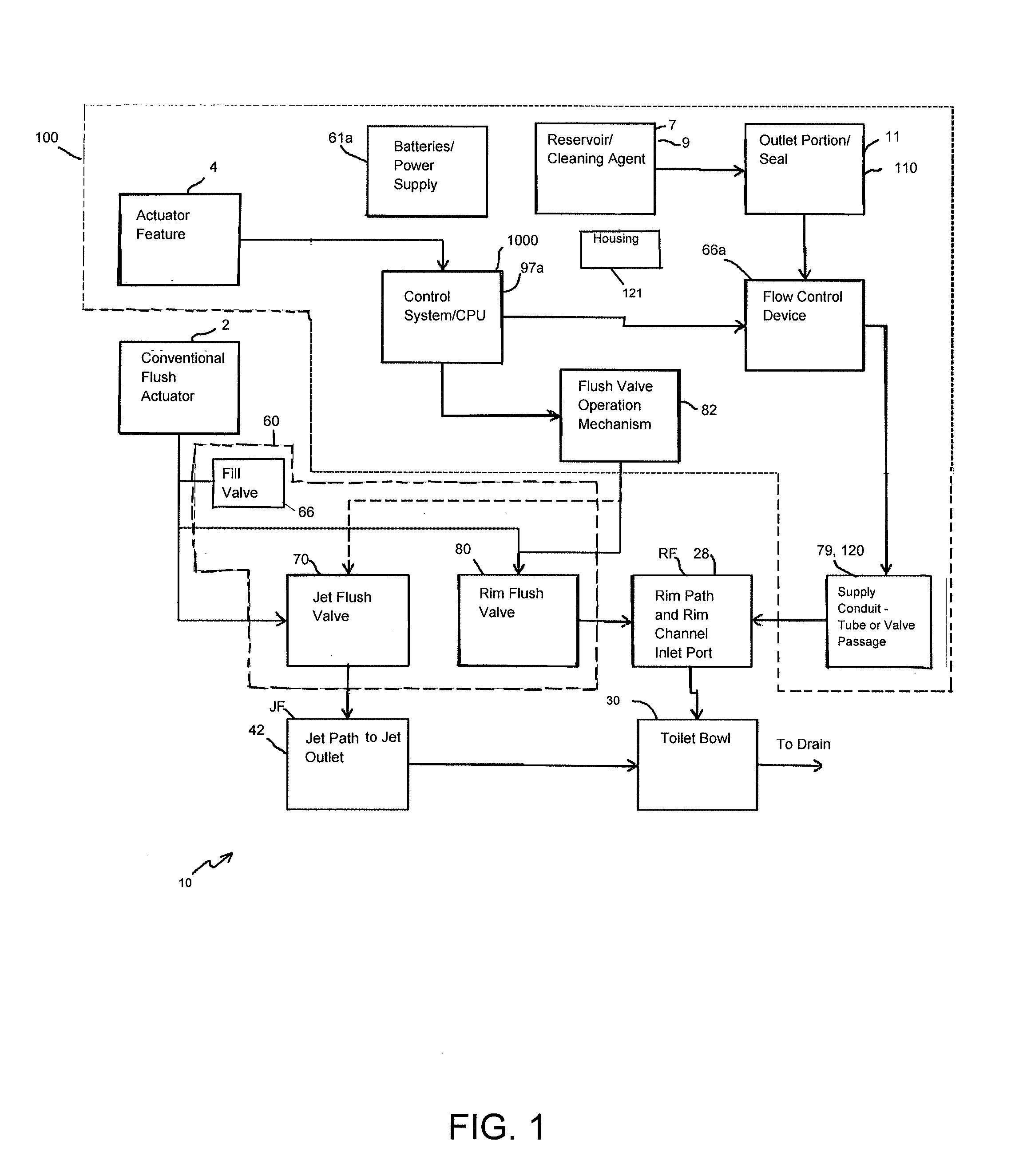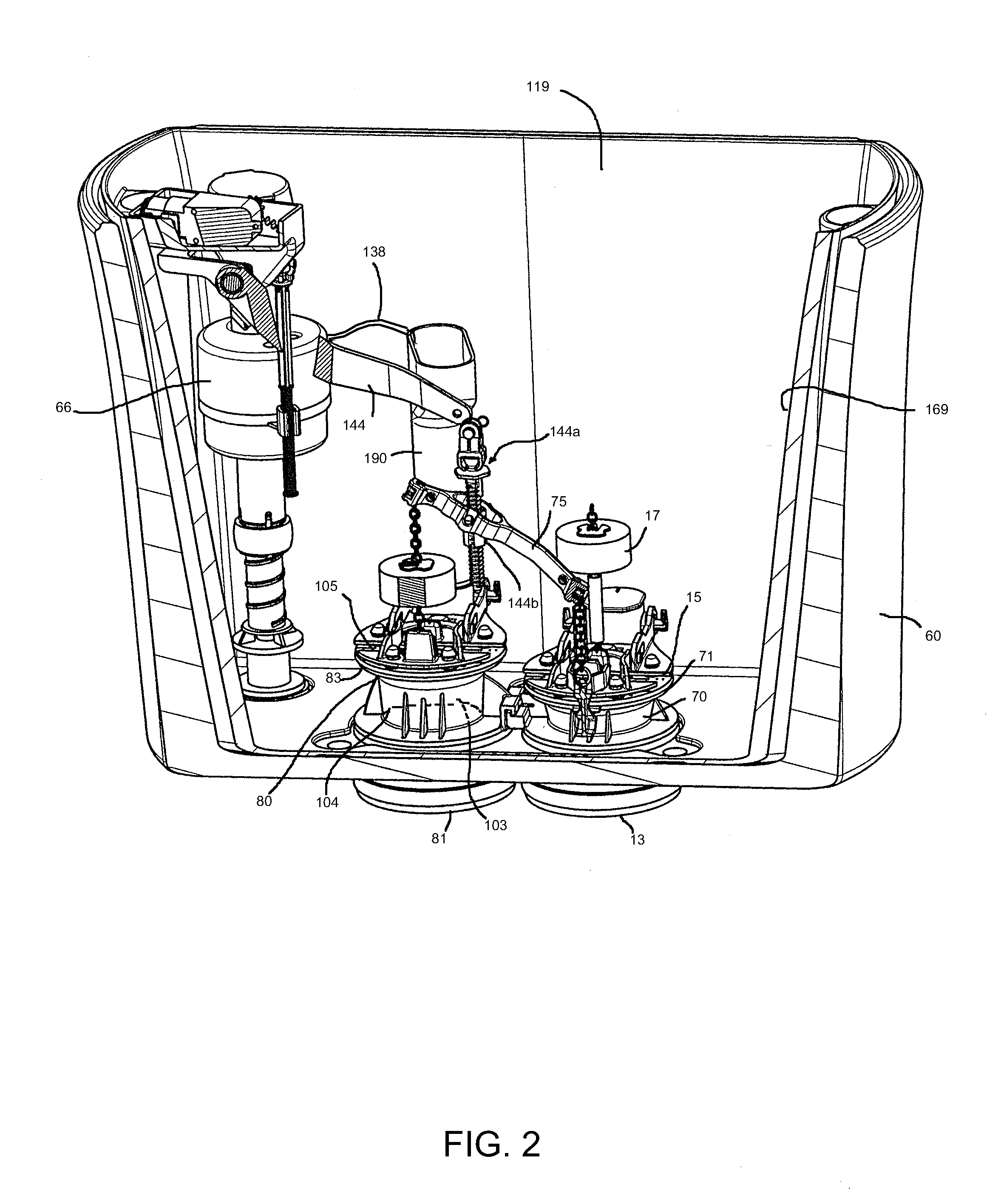Self-Cleaning Toilet Assembly and System
a self-cleaning, toilet technology, applied in the field of flushing toilets, can solve the problems of poor performance in bulk removal, rapid rise in water level, and manual cleaning of the bowl, and achieve the effect of excellent cleaning ability
- Summary
- Abstract
- Description
- Claims
- Application Information
AI Technical Summary
Benefits of technology
Problems solved by technology
Method used
Image
Examples
embodiment 400
[0166]The flapper lift mechanism is positioned on or around a valve body of the rim flush valve and the lift mechanism upon mechanical actuation by a gear motor when actuated by the control system, can lift and manually operate the rim flush valve during the clean cycle and / or a flush cycle. In a conventional flush cycle, the rim and jet flush valves are preferably operated by a flush actuator as described herein. The flush handle may be part of the flush valve operation mechanism 82 as described for example in this embodiment 10 as well as embodiments 500 and 1900 to open the rim flush valve. Or the flush valve operation mechanism 82 may be a form of mechanized flapper lift mechanism with a lift rod as in the embodiment 400. Various flush operation mechanisms may operate by a gear motor activatable by the control system for operating the flush valve. A flow control device for metering of solution, using a gear pump and / or gear motor, a peristaltic pump, a rotating device and the li...
embodiment 10
[0184]The sump area 40 of the bowl preferably has a jet trap 41 defined by the interior surface 39 of the bowl 30. The jet trap 41 has an inlet end 46 and an outlet end 50. The inlet end 46 of the jet trap receives fluid from the jet outlet port 42 and the interior area 37 of the bowl 30 and the outlet end 50 of the jet trap 41 receives that flow which enters into the inlet 49 to the trapway 44. The jet trap has a seal depth. The seal depth may be varied along with the jet paths and the measurement of the depth and all such variations may be readily incorporated into and operable in the embodiment 10. Such variations are described in detail in International Publication No. 2014 / 078461, incorporated herein in relevant part to describe variations in jet path and seal depth options for this particular toilet assembly.
[0185]To maintain a siphonic flush toilet assembly such as assembly 10 in a primed state, the initial step is to provide a toilet bowl assembly having the features as desc...
embodiment 100
[0261]The toilet bowl 30 may be of a variety of shapes and configurations as with toilet 10 in embodiment 100 described herein, and may have a variety of toilet seat lids and / or lid hinge assemblies. As such lids and are optional they are not shown in the drawings, and any suitable lid known or to be developed may be used with the invention.
[0262]As shown in FIG. 13, the shelf 27 can extend around almost the entire interior surface. It terminates to induce a vortex flow effect for cleaning. A rim shelf design can also accommodate multiple rim shelves and multiple rim inlets as described in co-pending U.S. Publication No. 2013 / 0219605 A1, incorporated herein by reference in relevant part in terms of describing rimless features. A similar design as shown in U.K. Patent Application No. GB 2 431 937 A or any future variations of such designs, wherein the bowl is formed without the traditional hollow rim and water is directed around a contoured interior surface of the bowl in an upper pe...
PUM
 Login to View More
Login to View More Abstract
Description
Claims
Application Information
 Login to View More
Login to View More - R&D
- Intellectual Property
- Life Sciences
- Materials
- Tech Scout
- Unparalleled Data Quality
- Higher Quality Content
- 60% Fewer Hallucinations
Browse by: Latest US Patents, China's latest patents, Technical Efficacy Thesaurus, Application Domain, Technology Topic, Popular Technical Reports.
© 2025 PatSnap. All rights reserved.Legal|Privacy policy|Modern Slavery Act Transparency Statement|Sitemap|About US| Contact US: help@patsnap.com



